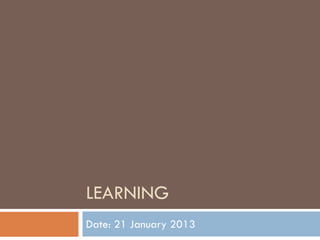
Learning
- 1. LEARNING Date: 21 January 2013
- 2. Learning It implies a progressive change in behavior It involves new ways to adjust oneself to new situations. It is the acquisition of knowledge, attitude and skills
- 3. Learning Definition by Crow and Crow: Learning is the acquisition of habits, knowledge and attitudes. It involves new ways of doing things and it operates on an individual’s attempt to overcome obstacles or to adjust to new situation. It represents progressive changes in behavior. It enables him to satisfy interests to attain a goal.
- 4. Implications of Teaching Who is to teach? Whom to teach? Why to teach? Where to teach? What to teach? How to teach? When to teach?
- 5. Implications of Learning Learning is interesting and effective when It is challenging There is an active involvement of students and teachers The students are motivated Individual potentials are identified and treated accordingly Feedback is provided It is participatory and threat free
- 6. Implications of learning… Learning is interesting and effective when Students can transfer what he has learned, to live situation Learners know their progress It is student centered
- 7. Integration of Teaching-Learning in T-L-P Teacher as independent variable Student as the dependent variable Content and the strategy of presentation as intervening variable
- 8. Teaching-Learning: two or three way communication? ?
- 9. Major input areas for the success of T-L Process 1. Curriculum 2. Maxims of teaching 3. Teaching methods and its selection 4. General Principles of learning and motivation 5. Teaching aids and its selection 6. Quality of a good teacher
- 10. 1. Curriculum • Objectives determined, mapping of scope and Analysis sequence, content determined • Develop lesson plans, select instructional strategy, Design select materials, identify management system • Integrate learning of students, individualizing Implementation instruction, establish learning climate, manage time… • Select evaluation criteria, collect sample evidence, assess in terms of goals and objective of Evaluation learning
- 11. 2. Teaching methods and its selection i. Human factors a) The teacher b) The students ii. Objective of learning iii. Subject area iv. Time and materials Factors
- 12. Teaching aids Teaching aids are those materials which are used by the teacher to make learning more interesting and understandable. Various types of teaching aids (resources): Pictures Flannel Board Overhead Projector Diagram Chalk Board Multimedia Projector Models Flip Chart Motion Pictures Mock-ups Charts Video Tape Instruction Sheet Television Computers
- 13. Purpose of Teaching aids To maximize the use of senses through hearing, sight , touch, taste and smell To enlarge small items for better observation To reduce large items for showing classroom- a hydraulic system To show hidden view – a cutaway model of an engine To show moving parts- show motion photography
- 14. Purpose of Teaching aids… To simplify objects in the form of diagram/models by showing desired parts To supplement demonstration & explanation To view unavailable experience, tool, objects etc. To view animated effect through motion pictures To view difficult process through motion picture
- 15. Character of good teaching aids Simple and to the point Suitable and relevant to the tasks Meaningful and purposeful Large enough to be properly seen by the students Cost effective in terms of time and money Interesting and Challenging
- 16. Types of Teaching aids Written materials Printed materials: textbook, Handouts, journals, magazines etc. Materials developed for facilitating teaching: lesson plan, instruction sheets etc. Audio-visual materials: Transparencies, graphics/charts, pictures, films, computer/laptops, television etc. Manipulative materials: Physically handled materials. Models, specimens, experiments etc.
